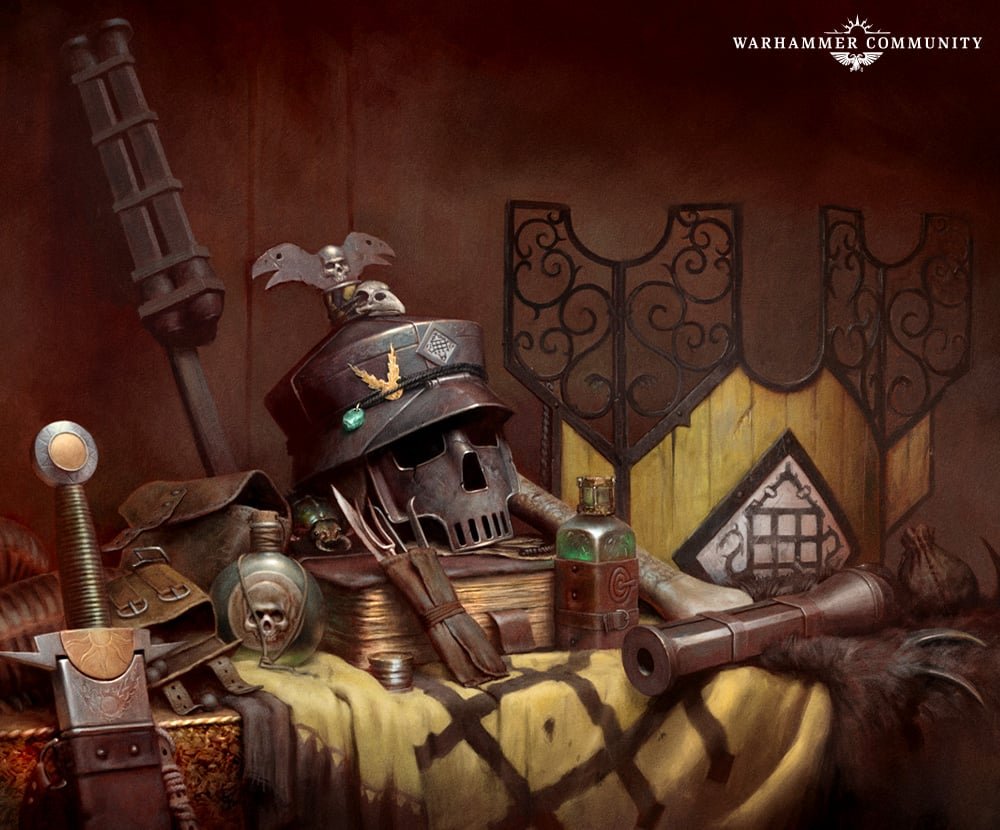Kindling the Flames: Cities of Sigmar Preview
The Great Wheel turns yet again as we look at Kindling the Flames for the Cities of Sigmar. They’ve taken a drastic turn from their previous iterations, and we’ll dive deep into how to express your own Dawnbringer Crusade using the new rules, territories, quests, and veteran abilities available in this Path to Glory section.
Toss A Coin to Your Dawner
The realms are covered in the scourge of chaos, the chill of death, and the fury of destruction. Oppressive enemies surround you on all fronts and the gods themselves want to bring an end to your city. Despite this, you still chose to take the coin and march out to reclaim the lands. You are no demigod, forged with lightning. You are a simple mortal, willing to die for what is right. And that is enough.
In this book, you’re given the tools to strike back against the darkness and build your own settlement.
Defining Mechanic: On Crusade
This book has the largest twist on Path to Glory in its Crusade mechanic. When you start your Path to Glory campaign, you have four major changes to how your army is constructed.
You do not have any territories and cannot gain territories
You are on the march, you may pass by the territories of the realms, but you aren’t able to bring them under your control.
Order of Battle limitations do not apply to you
You have free reign to create the army that you want. Does your Hallowheart crusade consist entirely of Battlemages and Hurricanums? Fantastic. Feel free to roll out of Greywater Fastness in a convoy of Steam Tanks. The only thing to be aware of is that Allies are still restricted to being one unit out of every four. That is a Core Rule and isn’t changed in Path to Glory.
You do not have a Stronghold and cannot establish an Outpost
Falls under the same logic as the first point. What really sucks is that you cannot get the benefits from the Dawnbringers: Harbinger book until you finish your crusade.
The only quests you can embark on are the ones in this book
They’re all very cool quests, but it means that you won’t be able to add certain things to your army, such as Anvil heroes, Harbingers, Incarnates, artifacts, spells, etc. You don’t have a Vault to store them all in yet.
These opening points give you a lot of freedom in building your army, but until you complete your crusade, you are dealing with some hefty limitations. So the question becomes, how do you complete the crusade?
To complete the crusade you need to gather 25 Crusade Points. You can earn these through quests and playing games. Major victories get you d6+3, minor victories net you d3+2, ties give you 1 whole point and losses will set you back by 1. Easy enough, but the real flavor comes in what happens after your games.
Setbacks and Blessings
In step 1 of the Aftermath sequence, you get to roll on either the Setbacks or Blessings tables. If you score a victory in your battle, you get to roll for a Blessing. The benefits here range from free renown, quest points, and crusade points. But they could also reduce the casualty score of your units or even give you a free unit at no glory cost.
If you didn’t win, you have to roll for a Setback. These things can be rough. Your units can suffer casualties, be unable to recuperate, and be unable to become your favored warriors. One of the worst options is Low Ammunition. After any time a unit shoots in your next battle, you roll a die. On a 1 that unit is unable to shoot for the rest of the battle. If you’re taking a Greywater Fastness gunline army, this Setback will absolutely throw a wrench in your battle plan.
In the lore, Dawnbringer Crusades fail more often than they succeed and now it’s easy to see why. If you march out into the wilds, you have to acknowledge that you may have to scrap a crusade and start over with a new batch of bright-eyed warriors.
Founding Your City
Once you’ve got your Crusade Points, you must fight the special battleplan Await the Coming Dawn. If you win, you can finally settle down and build your settlement. Three things happen when you do.
You set your Order of Battle limitations to match what is in your army. Did your 20 battlemages make it to the end? Congratulations! Now your new Order of Battle limitation can go to 20 heroes and 20 wizards. If you didn’t have any units of that type (ex. Priests), you set that limit to 1.
You receive a Stronghold and pick 1 Cities of Sigmar territory of your choice. This lets you establish the theme of your settlement instead of relying on random rolls.
Each unit in your Order of Battle that’s not a hero gains a special First Founding Veterans veteran ability. What’s special about this is that they get this alongside the 3 normal veteran abilities they get through renown, allowing your units to have up to 4 veteran abilities. This is the only way to gain this veteran ability, so units you add after the fact do not get it. It highlights the toil and strife these units had to go through to get found this city.
New Quests
The book includes 4 quests that you can go on while you are on Crusade. Each of these represent different trials you might face while marching across the realms Specifically, they are geographical hurdles you must face.. One I want to focus on is Across the Plains. While you are on this quest, everytime you roll on the Setbacks table, you roll 2 dice and pick the result. This gives you more control over the issues you can come across during your campaigns.
For all of these quests, you gain Quest Points for each unit you have that is in enemy territory at the end of the battle. This is a clever way to bring the narrative of the campaign into your games. Your army is not there to defend objectives. You are marching forward and to complete these quests, your soldiers need to move across the battlefield.
In order to complete Across the Plains, you roll a dice at the end of each battle and add your Quest Points to the roll. On a 12+, you move to the next step where you play the Sudden Assault battleplan out of the Core Rulebook. At the end of that battle, you complete the quest and gain more crusade points. Hooray!
New Veteran Ability
The veteran abilities in this book highlight some of the play styles you can dive into when you build your army. The book breaks up your army into sections of aelves, duardin, and humans in terms of synergies. Each of those groups have their own veteran ability that focuses on their playstyle. Castellite units and Ranged units also get their own bonuses if you choose to build a gunline or a shield-wall formation.
One veteran ability to look out for is Unwavering Resolve. This veteran ability is available to any unit in your army and allows them to rally even when they are within 3” of enemy units. No matter what army you plan on building with this battletome, you’re going to want this on your units. This will either give them the push they need to take down the enemy or allow them to hold the line for even longer.
Territories
Every territory is new in this book, with some focusing on the aelven, duardin, and freeguild subgroups. But there are two that work in tandem that add a new twist to your path to glory games.
First is Guardian Idol. This may sound familiar because it ties directly to the Guardian Idol terrain piece. Normally, the Cities of Sigmar do not have any faction terrain. But this territory allows you to place a Guardian Idol as if it were faction terrain. Friendly Cities of Sigmar units within 3” of the Guardian Idol have a 6+ Ward. Put this in your backline surrounded by your Fusiliers and you’ve got a castellite formation that becomes ever harder to break down.
The second territory is the Geomantic Nexus. With this, you can place the Nexus Syphon terrain piece as if it were faction terrain. If it is within 24” of your Guardian Idol, then the ward the Guardian Idol gives out is now a 5+.
In the lore of the Dawnbringer Crusades, these two pieces of terrain help defend your settlements from attacks. Now, that is reflected in your games as it bolsters your units that hang back in your territory.
Name Generator
A lot of the more recent battletomes have included name generators and this one knocks it out of the park. There are 10 different tables to pick from when you create your characters. The first 8 represent each of the mortal realms and the final 2 are for the duardin and aelven races. On top of that, there are 3 additional tables of narrative quirks to help define your characters.
As an example I came up with: Ynradi Aetherscribe, a homesick aelf who wants to go back home to Azyr.
Narrative Battleplan
So, you’ve got your crusade points and found the perfect place to construct your settlement. Unfortunately, the night before you can break ground, you are ambushed. Now you must Await the Coming Dawn.
This battleplan puts you on the defensive while you're attacked by enemy hordes. The attacking player can nominate non-hero units to be ‘horde’ units. They don’t have any renown or veteran abilities and won’t have to worry about the aftermath sequence. The benefit is that when a horde unit dies, it can come back to torment the Dawnbringers. However, it’s still a good idea for the attacking player to keep a few non-horde units around.
The Dawnbringer has to defend their territory, full-stop. If there are no Dawnbringer units in the Dawnbringer territory at the end of a battle round, the game ends and the Dawnbringers lose. In order to win, you must hold out through the dawn.
At the end of the third battle round, as well as any subsequent battle round if necessary, the Dawnbringer rolls a die and adds the number of the current battle round to it. On a 9+ the Dawnbreaks. When dawn breaks, the Dawnbringer units no longer have to make battleshock tests and they can rally even when they’re within 3” of enemy units.
If at the end of a battle round, the dawn has broken and there are no enemy units (excluding horde units) in the Dawnbringer territory, the Dawnbringers win.
While victory allows the Dawnbringer to build their settlement at the site of the battle, a similar thing happens for the attacker. If they manage to pull out the win, they can add a territory of their choice to their Stronghold.
This battleplan is a whole lot of fun. It really bakes in the narrative that your soldiers are holding on for dear life during the night. Yet when the dawn breaks, suddenly they are invigorated and are able to push back the darkness. To bake that idea into the rules themselves is such a cool thing and will lead to a lot of fun moments on the battlefield for you and your opponent.
Warscroll Battalions
Finally, there’s the new warscroll battalions. There’s the duardin warscroll battalion Grudgebound War Throng which makes it harder for your opponent to wound your duardin in the late game. As well as the aelven Thrall Warhost, which allows a Sorceress to command her underlings to be more lethal. But the one I want to focus on is the Castellite Formation.Now I know what some of you are thinking. “Isn’t there a Matched Play battalion for the Castellite Formation?” The answer is yes, but like all things, the narrative players get the better version.
While matched players get a measly one-time use of All-Out Attack or Unleash Hell, the narrative Castellite Formation is a shield wall that will not cower. Whenever a unit receives the Inspiring presence command, you can roll a die for every unit in this battalion within 12” of the receiving unit. On a 4+, they also don’t need to take battleshock tests.
Your guns can keep firing into the enemy forces and your soldiers will hold the line!
Final Thoughts
Wowza, this book has got a lot of fun narrative stuff! We’ve seen other battletomes try to make small changes to Path to Glory to add onto the narrative of the army. But this book takes that to the next level. You’ve got an immediate story hook with sending your army out on crusade. There are definite steps and goals for you to achieve while you play your games. But you’re able to still make your own choices in how that narrative plays out. By and large this is probably my favorite twist on the Path to Glory system.
Thanks for sitting alongside the fire with us and we hope to see you along the path.



